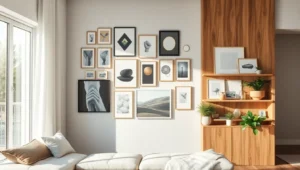In a world overflowing with clutter and chaos, minimalist decorating style emerges like a breath of fresh air. It’s not just about empty spaces and bare walls; it’s a lifestyle choice that promises serenity and simplicity. Imagine walking into a room where every piece has purpose, and your mind can finally take a break from the visual noise.
Minimalism isn’t about sacrificing comfort for aesthetics; it’s about elevating your space to reflect clarity and intention. With a dash of creativity and a sprinkle of humor, anyone can transform their home into a chic sanctuary. So why not trade in the overwhelming for the understated? Minimalist decorating might just be the antidote to your design dilemmas, making your space not just stylish but also a joy to live in.
Table of Contents
ToggleUnderstanding Minimalist Decorating Style
Minimalist decorating style embodies simplicity and intention in design. This approach creates serene spaces while prioritizing comfort.
Key Characteristics
Minimalism showcases clean lines and uncluttered spaces. Neutral color palettes dominate, offering tranquility and focus. Functional furniture contributes to efficiency without excessive ornamentation. Natural light plays a vital role, enhancing openness. Each element serves a purpose, eliminating distractions. Open floor plans promote a sense of spaciousness.
Benefits of Minimalism
Minimalism reduces stress by fostering calm environments. This style encourages mindfulness through intentional design choices. It simplifies cleaning and maintenance with fewer items to manage. Flexibility increases, allowing for easy changes in decor as needs evolve. Cost savings occur, as quality over quantity guides purchases. Embracing minimalism leads to enhanced clarity in one’s living space.
Getting Started with Minimalist Decorating
Minimalist decorating focuses on essential elements to create an inviting space. Following specific steps helps in achieving a minimalist aesthetic effectively.
Decluttering Your Space
Start by assessing all items in each room. Keep only what serves a purpose or brings joy. Removing unnecessary items significantly enhances spatial clarity. Consider categorizing belongings into keep, donate, and discard piles. Focus on surfaces first; clear countertops, shelves, and tables to create a calm environment. Regularly revisiting these areas helps maintain a clutter-free space. Utilize storage solutions that blend seamlessly with the decor, enhancing functionality while preserving simplicity.
Choosing a Color Palette
Opt for a neutral color palette to foster tranquility. Soft whites, grays, and beiges create an airy feel throughout the home. Incorporate one or two accent colors for depth, avoiding overwhelming hues. Shades of green or blue provide a touch of nature while maintaining minimalism. Experimenting with different textures can add interest without cluttering. Balance light and dark colors to establish harmony within spaces. Use these colors consistently across different rooms to strengthen the overall aesthetic.
Essential Elements of Minimalist Design
Minimalist design revolves around a few key elements that foster simplicity and functionality. Emphasizing these aspects cultivates serene spaces.
Furniture Selection
Furniture choice hinges on functionality and simplicity. Opt for pieces that have clean lines and serve a clear purpose. Prioritize quality over quantity to achieve longevity in design. Each item contributes to a cohesive aesthetic while avoiding visual clutter. Consider multi-functional furniture, such as a sofa bed or a coffee table with storage, to maximize space without sacrificing style. Additionally, stick to neutral colors like white, gray, or beige for a timeless look.
Accessories and Decor
In minimalist design, accessories and decor play a crucial role but require careful selection. Choose a few impactful artworks or statement pieces instead of numerous smaller items. Incorporate natural materials like wood or stone that add warmth without overwhelming a space. Limit decorative items to those that evoke emotion or serve a purpose, ensuring they harmonize with the overall aesthetic. Natural light should enhance these elements, creating a bright and inviting atmosphere. By focusing on quality and intentionality, accessories can elevate minimalist spaces effortlessly.
Tips for Achieving a Minimalist Look
Achieving a minimalist look involves intentional design choices that focus on simplicity and functionality. Following effective strategies helps create peaceful living spaces.
Balancing Functionality and Aesthetics
Prioritize selecting furniture that blends both beauty and utility. Rooms benefit from multi-functional pieces, such as a coffee table that doubles as storage. Avoid overcrowding with excessive items; instead, place a few impactful elements that signify personal style. Embrace open space to enhance flow, which encourages relaxation and clarity. Remember that each piece should serve a purpose while contributing to the overall design ethos.
Incorporating Nature
Utilize natural materials to foster an organic, inviting atmosphere. Wood, stone, and metal elements create a harmonious connection with the outdoors. Large windows optimize natural light, promoting a bright and airy environment. Including indoor plants adds warmth and life to minimal spaces, enhancing tranquility. Select greenery that reflects personal preferences, taking care to avoid clutter and maintain simplicity in arrangement.
Common Mistakes to Avoid
Minimalist decorating brings serenity but often leads to mistakes if one isn’t careful. Awareness of common pitfalls can enhance the minimalist experience.
Overcomplicating Spaces
Minimalist design thrives on simplicity, yet many individuals mistakenly fill their spaces with excessive items. Choosing fewer, impactful pieces creates a calm atmosphere. Room layouts may become cluttered when too many decorations are added. Identify focal points instead of overwhelming the senses with multiple decorations. Functional furniture can contribute to minimalism by serving multiple roles, thereby maximizing space. A well-organized area encourages tranquility, so strive for balance.
Misunderstanding Minimalism
Many people associate minimalism solely with empty spaces, yet it embodies thoughtful curation. Prioritizing functionality over mere aesthetics enriches the living environment. Intentional design choices enhance purpose, moving beyond just less clutter. Misinterpretations of minimalism often lead to sterile, uninspired settings instead of inviting spaces. Selecting significant items that evoke emotion establishes a connection to the environment. Understanding that minimalism operates as a lifestyle fosters a more enriching experience.
Conclusion
Embracing a minimalist decorating style can transform any space into a serene sanctuary. By focusing on simplicity and intentional design choices, individuals can create environments that promote clarity and peace. The thoughtful selection of furniture and decor not only enhances functionality but also fosters a deeper connection to one’s surroundings.
As one navigates the path to minimalism, the journey towards a clutter-free and mindful living space becomes a rewarding experience. With practical steps and an understanding of minimalist principles, anyone can achieve a tranquil home that reflects their values and lifestyle. Ultimately, minimalism isn’t just a design choice; it’s a way of life that encourages joy and contentment in the everyday.





